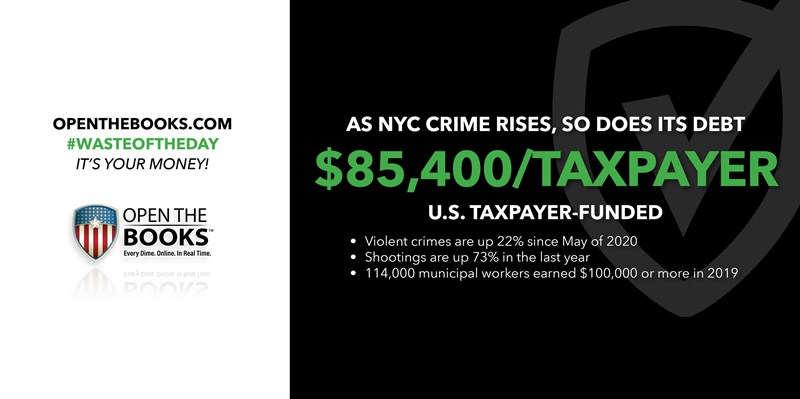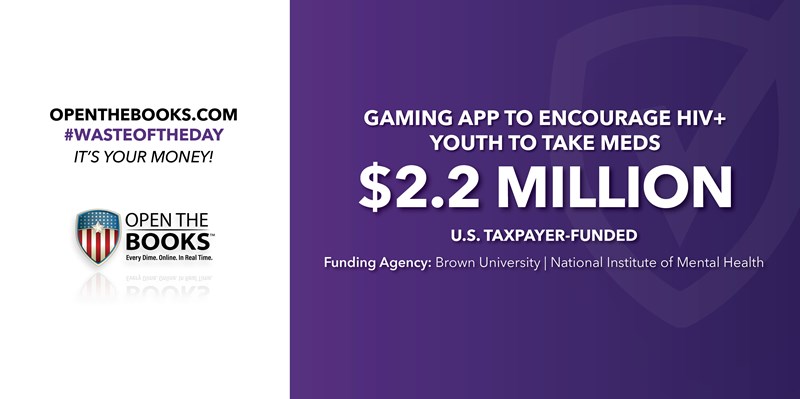
New York City Taxpayers Owe $85,400 Each in City Debt Burden | July 19, 2021

As NYC struggles with crime, its debt also rises. New York City’s finances are in trouble.
The debt is so high that if broken down by taxpayer, each would owe $85,400 — while the national debt per taxpayer is around $225,000.
That’s according to Truth in Accounting, a nonprofit think tank that analyzes government finances at the city, state, and federal level. Their recent analysislooked at the 10 most populous cities and how their debt impacts taxpayers in those cities.
That $85,400 number is stark because regular citizens could never pay that kind of government debt. Yet, the NYC gravy train rolls on…
Our auditors at OpenTheBooks.com found that in 2019, the latest year available, the Big Apple had more than 114,000 municipal workers earning $100,000 or more in 2019. That’s up 50% in just four years. (There were 76,166 such employees in 2016.)
In October, Moody’s Investors Service lowered the credit ratings of both the state and city, and in December, Fitch Ratings downgraded the city’s bond rating and issued a negative outlook.
This is as violent crime has surged — according to NYPD crime stats, there’s 22% more violent crime since May of 2020 and shootings are up 73% in the last 12 months.
New York City is shaping up to be a bankrupt city where tourists can’t go shopping in Times Square without fear of getting shot.
U.S. Funding Peru’s Film Industry for $25,000 | July 20, 2021

Among Peru’s many problems with violence, human rights violations, and threats to freedom of expression, is an issue that the U.S. apparently feels is grave enough to fight: the lack of women in Peru’s film industry.
The U.S. Mission to Peru is giving $25,000 to “support women in the film industry in Peru, given the challenges posed by the Covid-19 pandemic to the film sector and the cultural industry in general.”
Filmmakers, producers, film technicians, cultural and education institutions and film guilds who apply for the grant should be able to create training opportunities throughout Peru, promote safer working conditions, and generate more opportunities to collaborate and share ideas with the U.S. film industry, the grant summary states.
“The program will support female directors, producers, technical teams, and screenwriters, amplifying their voices, and helping them overcome gender-based challenges that hinder their ability to work in the field,” the summary says.
The organization that gets the grant should hold courses and organize conferences with American women who are specialists on issues in the film industry to help promote more film projects led by women.
There are probably better ways to help Peruvian women.
Federal Gardeners and Landscapers Earned $44 Million in Salary Last Year | July 21, 2021

The lush green gardens outside federal buildings and government-owned properties don’t landscape themselves.
No, their caretakers are among the 610 federal gardeners and landscapers that cost taxpayers $44 million in 2020.
The growers, employed in two job categories of “Landscape Architecture” and “Gardening,” are hired by more than 10 departments and independent agencies, spread out over almost two dozen subagencies.
Average pay for a landscape architecture employee was $99,480 in 2020, positions that are typically held by degreed professionals with credentials in planning and designing landscapes.
Gardeners received a much lower average pay of $54,236, but that's before considering the extra 35 percent in lucrative benefits.
There were 105 landscape architects who earned more than $100,000 in FY2020 in base salary alone.
Todd D. Alexander made the most — $166,848 working for the Interior Department; Andrew R. Lamendola made $162,189 working in the Dept. of Veterans Affairs; Christian D. Gabriel made $157,709 with the General Services Administration; Kristie R. Franzmann and Jodie A. Petersen each made $157,578 in the Interior Department.
$44 million is a pretty penny to pay for mowing lawns, trimming bushes and planting flowers.
In 1977, The Labor Department Spent $1.7 Million on a Door-To-Door Census “Is Your Dog Vaccinated?” | July 22, 2021

Throwback Thursday!
Have you ever wondered how many dogs, cats and horses are in your county?
The people of Ventura County, California were given $385,000 ($1.7 million in 2021 dollars) in 1977 by the U.S. Department of Labor to hire 101 people to do a door-to-door survey of the 160,000 houses and apartments and count the animals.
The funding was awarded under the Comprehensive Employment and Training Act (CETA), a law signed in 1973 to train workers and help them get jobs in public service.
While CETA funds are supposed to help provide jobs, they’re also used to meet a local, urgent need, which, according to the proposal for this project, meant finding out how many dogs hadn’t been vaccinated against rabies.
The animal regulation director of Ventura County had already assured the staff of U.S. Sen. William Proxmire, a Democrat from Wisconsin, that there hadn’t been a documented case of rabies in dogs or cats in more than a decade.
That misuse of the CETA funding earned this project a Golden Fleece award from Proxmire.
While the U.S. Constitution requires a census count of the human population every 10 years, it makes no mention of animals.
Mobile Gaming App Cost Taxpayers $2.2 Million and Encouraged HIV Youth to Take Meds
| July 23, 2021

Brown University has a $4.7 billion endowment, but it still collected $756.8 million in grants since 2017, including $2.2 million to create a mobile gaming app to encourage youth living with HIV to regularly get treatment.
Brown collected the money from the National Institute of Mental Health since 2018 for BattleViro, a mobile gaming app that seeks to improve adherence to antiretroviral treatment for HIV.
The study notes that antiretroviral treatment leads to decreased morbidity and the number of hospitalizations. But adolescents and young adults have low rates of adherence to the medications and low rates of retention in care as compared to older adults.
“Novel and engaging digital approaches are needed to help adolescents and young adults living with HIV be adherent to treatment,” according to the abstract.
Researchers developed the iPhone game to encourage them to adhere to treatment more regularly, completing the study with the participation of 20 young adults in a Rhode Island HIV clinic.
They said it was “a significant step in working toward the development and testing of an iPhone gaming app intervention to promote adherence to antiretroviral treatment.”
The #WasteOfTheDay is presented by the forensic auditors at OpenTheBooks.com.